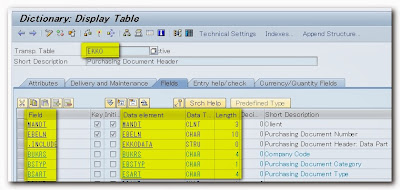Here's the Part 2 of this compiled ABAP questions. Enjoy answering. You can view the first part in this link:
21. What must you code in the flow logic to prevent a module from being called unless a field contains a non-initial value (as determined by its data type)?
A: ON INPUT
B: CHAIN
C: FIELD
D: ON REQUEST
22. The AT USER-COMMAND event is triggered by functions defined in the ____.
A: screen painter
B: ABAP report
C: menu painter status
D: ABAP Dictionary
23. In regard to a function group, which of the following is NOT a true statement?
A: Combines similar function modules.
B: Shares global data with all its function modules.
C: Exists within the ABAP workbench as an include program.
D: Shares subroutines with all its function modules.
24. In regard to SET PF-STATUS, you can deactivate unwanted function codes by using ____.
A: EXCLUDING
B: IMMEDIATELY
C: WITHOUT
D: HIDE
25. In regard to data transported in PAI when the FIELD statement is used, which of the following is NOT a true statement?
A: Fields in PBO are transported directly from PAI.
B: Fields with identical names are transported to the ABAP side.
C: Fields not defined in FIELD statements are transported first.
D: Fields that are defined in FIELD statements are transported when their corresponding module is called.
26. The order in which an event appears in the ABAP code determines when the event is processed.
A: True
B: False
27. A field declared as type T has the following internal representation:
A: SSMMHH
B: HHMMSS
C: MMHHSS
D: HHSSMM
28. Which of the following is NOT a component of the default standard ABAP report header?
A: Date and Time
B: List title
C: Page number
D: Underline
29. Assuming a pushbutton with function code 'FUNC' is available in the toolbar of a list report, what event is processed when the button is clicked?
A: AT USER-COMMAND.
B: AT PFn.
C: AT SELECTION-SCREEN.
D: END-OF-SELECTION.
30. In regard to field selection, what option of the SELECT statement is required?
A: FOR ALL ENTRIES
B: WHERE
C: INTO
D: MOVE-CORRESPONDING
31. The following program outputs what?
report zjgtest1
write: /1 'Ready_'.
PARAMETER: test.
INITIALIZATION.
write: /1 'Set_'.
START-OF-SELECTION.
write: /1 'GO!!'.
A: Set_ GO!! (each on its own line)
B: Set_ Ready_ GO!! (all on their own lines)
C: Ready_ GO!! (each on its own line)
D: Ready_ Set_ GO!! (all on their own lines)
32. To declare a selection criterion that does not appear on the selection screen, use:
A: NO-DISPLAY
B: INVISIBLE
C: MODIF ID
D: OBLIGATORY
33. An internal table that is nested within another internal table should not contain a header line.
A: True
B: False
34. What is output by the following code?
DATA: BEGIN OF itab OCCURS 0, letter type c, END OF itab.
itab-letter = 'A'. APPEND itab. itab-letter = 'B'. APPEND itab.
itab-letter = 'C'. APPEND itab. itab-letter = 'D'. APPEND itab.
LOOP AT itab.
SY-TABIX = 2.
WRITE itab-letter.
EXIT.
ENDLOOP.
A: A
B: A B C D
C: B
D: B C D
35. To select all database entries for a certain WHERE clause into an internal table in one step, use
A: SELECT_INTO TABLE itab_
B: SELECT_INTO itab_
C: SELECT_APPENDING itab
D: SELECT_itab_
36. After a successful SELECT statement, what does SY-SUBRC equal?
A: 0
B: 4
C: 8
D: Null
37. This selection screen syntax forces the user to input a value:
A: REQUIRED-ENTRY
B: OBLIGATORY
C: DEFAULT
D: SELECTION-SCREEN EXCLUDE
38. If the following code results in a syntax error, the remedy is:
DATA: itab TYPE SORTED TABLE OF rec_type WITH UNIQUE KEY field1
WITH HEADER LINE.
itab-field1 = 'Company'. itab-field2 = '1234'. INSERT TABLE itab.
itab-field1 = 'Bank'. itab-field2 = 'ABC'. INSERT TABLE itab.
SORT itab.
LOOP AT itab.
write: /1 itab-field1, itab-field2.
ENDLOOP.
A: There is no syntax error here
B: Remove the SORT statement
C: Change INSERT to APPEND
D: Add a WHERE clause to the loop
39. If this code results in an error, the remedy is:
SELECT fld1 fld2 FROM tab1 WHERE fld3 = pfld3.
WRITE: /1 tab1-fld1, tab1-fld2.
ENDSELECT.
A: Add a SY-SUBRC check.
B: Change the WHERE clause to use fld1 or fld2.
C: Remove the /1 from the WRITE statement.
D: Add INTO (tab1-fld1, tab1-fld2).
40. When modifying an internal table within LOOP AT itab. _ ENDLOOP. you must include an index number.
A: True
B: False





No comments:
Post a Comment